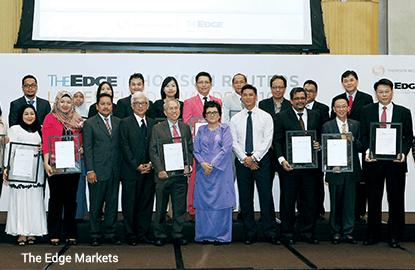
This article first appeared in Personal Wealth, The Edge Malaysia Weekly, on March 14 - 20, 2016.


CIMB-Principal Asset Management Bhd, Eastspring Investments Bhd, Amanah Mutual Bhd and Pheim Asset Management Sdn Bhd took home the top awards at The Edge-Thomson Reuters Lipper Awards 2016. The awards ceremony was held on March 7.
The prestigious Best Overall Group award went to CIMB-Principal, while Eastspring bagged the Best Equity Group award. Pheim clinched the Best Mixed Asset Group award and Amanah Mutual won the award for Best Bond Group.
RHB Asset Management Sdn Bhd won the most individual awards — 15 out of a total of 52. As at December last year, data on the Securities Commission Malaysia’s website showed that there were 612 unit trust funds in the market.
In her keynote address, Securities Commission Malaysia deputy chief executive Datuk Dr Nik Ramlah Mahmood said the awards play a valuable role in encouraging healthy competition among fund providers. She also dubbed the 17-year-old awards the “Oscars” of Malaysia’s fund management industry.
“Those of you who have been keeping up with the news will be aware that the first quarter of the year is awards season in Hollywood. I am pleased to see Lipper and The Edge keeping that vibe very much alive here in KL. Winning one these ‘Oscars’ for the fund management industry is certainly a prestigious recognition and I would like to congratulate all the winners for their achievements.”
Nik Ramlah, who will be retiring on March 31 after 23 years with the SC, says she is glad to see that the fund management industry did not only weather the economic headwinds last year, but grew 6%. The industry’s assets under management expanded to RM668 billion last year from RM630 billion in 2014.
Of the RM668 billion, unit trust funds accounted for about 52% of the industry’s total assets under management. Meanwhile, the units in circulation rose by more than 32 billion to 458 billion units last year.
“The ability of the industry to remain in a net overall sales position, even in a challenging environment, suggests that investors remain confident in the long-term value proposition of unit trust funds,” says Nik Ramlah.
Going forward, the SC will continue to facilitate intra-regional investment activity and further internationalise the Islamic capital market, she adds. “As the chair of the Asean Capital Market Forum, the SC will continue to facilitate intra-regional investment activity, including bringing on board other Asean members that have yet to sign on to the various market liberalisation measures that we have collectively crafted. At the same time, the SC’s efforts to further internationalise the Islamic capital market will create further opportunities for growth in this segment. The Islamic Fund and Wealth Management Blueprint, which the SC is finalising, will outline our strategies in building an ecosystem that is conducive for growth — focusing on strengthening the global capabilities of intermediaries, expanding international connectivity and capitalising on niche opportunities.”
Financial technology (fintech) platforms, such as robo-advisory services, which have seen dramatic growth in developed markets in recent years, are an important trend that the SC will continue facilitating as this will enhance the marketing reach and distribution channels as well as investor experience.
 Nik Ramlah urges financial intermediaries to be proactive in deploying the technology across various aspects of their business.
Nik Ramlah urges financial intermediaries to be proactive in deploying the technology across various aspects of their business.
The SC, for its part, has initiated work to facilitate the development of Malaysia’s fintech industry.
“It is clear, for example, that online distribution channels for unit trusts can benefit investors by driving cost competitiveness. But currently, less than 1% of unit trust transactions are conducted online, compared with stockbroking where the figure is 28%,” she says.
“More should be done by intermediaries to expand and promote their online distribution capabilities, and the cost advantages flowing through to end-investors can help spur further growth in the industry, thus enhancing its role as a key growth enabler in the overall capital market.”
Despite the increase in the industry’s assets under management last year, Thomson Reuters Lipper head of research for Asia-Pacific Xav Feng says 2015 was a challenging year for fund managers. “According to Thomson Reuters Lipper’s calculation and research analysis, the global fund market experienced a net outflow of US$287 billion in 2lu14 amid endless black swan events. In 2015, it posted net outflows of US$450 billion,” he adds.
Money market funds saw the highest net outflow globally, of almost US$700 billion, while equity and bond funds recorded almost US$150 billion and US$60 billion in outflows respectively. In contrast, mixed-asset funds attracted a net inflow of US$440 billion.
On a regional basis, the US and Japan posted positive net inflows of US$172 billion and US$131 billion respectively, says Feng. Europe and Asia ex-Japan saw more than US$415 billion and US$240 billion in net outflows respectively.
Malaysia recorded net outflows of US$1.5 billion in 2015, following net outflows of US$2.5 billion the year before. Equity funds were the only asset class to see net inflows (see chart).
“Besides equity funds, funds of all other asset types in Malaysia posted net outflows. Money market and bond funds suffered the biggest net outflows of more than US$1 billion,” says Feng.
The segments that continued to enjoy the highest net inflows in last year’s volatile market were those in the Equity Malaysia Income and Equity Malaysia Lipper categories.
